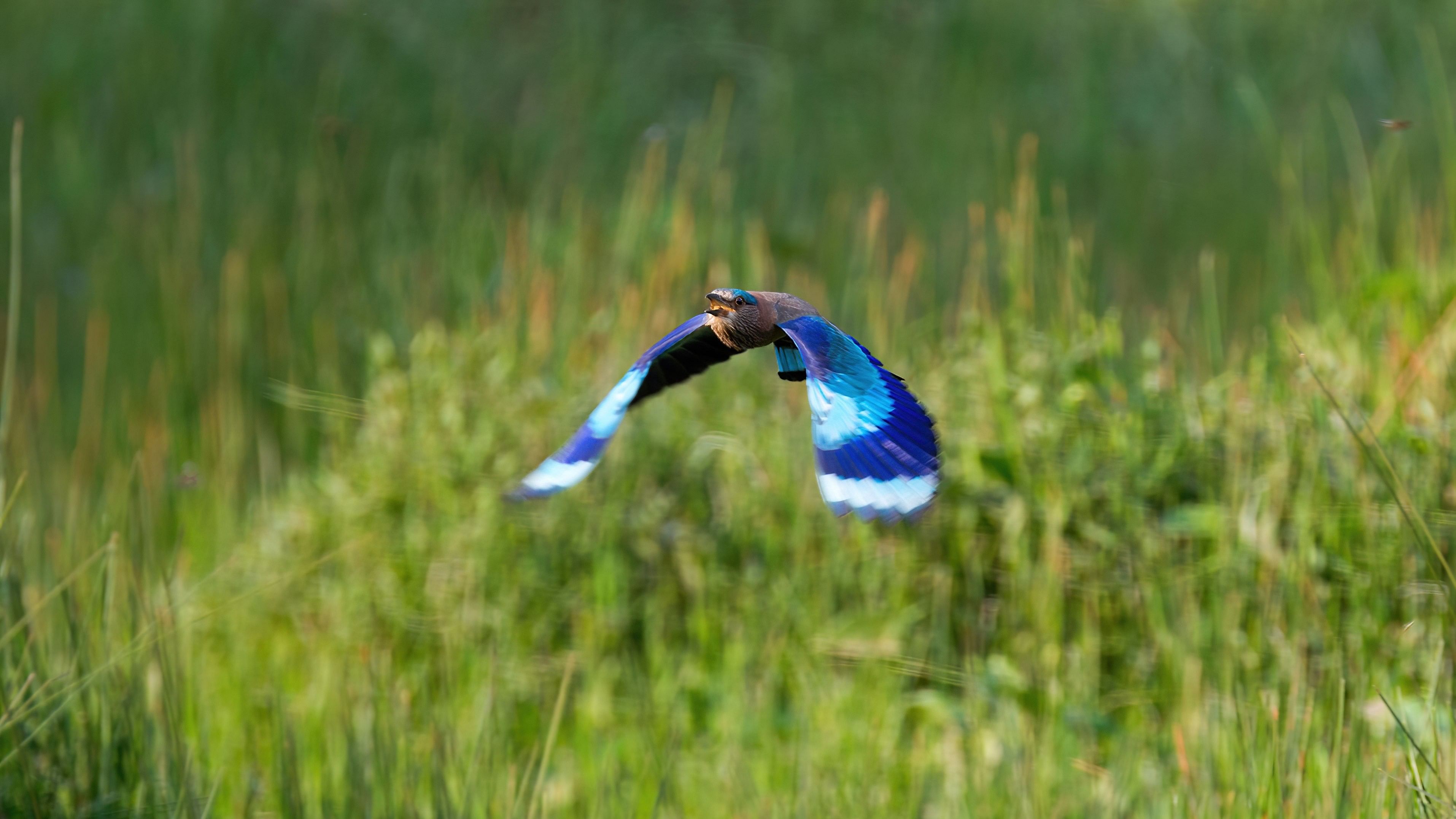
Indian Roller in flight.
Credit: iStock Photo
Bengaluru: Most of Karnataka’s land mass is blanketed by a cover of grass, peppered with a handful of trees. At first glance, such ecosystems might hold little significance in the eye of the beholder. Time and again, these rich biomes have been categorised as wastelands. In truth, they support and are home to a diverse species of animals, birds, insects and reptiles.
For instance, in the vicinity of Hesaraghatta lake, which is Bengaluru’s sole remaining grassland, researchers have documented approximately 235 bird species. The lesser florican, a bird thought to be extinct for 100 years, was rediscovered in 2011 in the Hesaraghatta grasslands.
Additionally, roughly 400 insect species have been identified, with nearly 30 being newly classified by entomologists. This area also serves as a breeding ground for around 100 butterfly species, including the elusive lilac silverline (Cigaritis lilacinus).
Grasslands contain a dizzying variety of grass species alone. There are about 1,500 recorded species of grass present in India. “About 30-40% of these species are found in Karnataka. Many are endemic to the region,” explains M Jadegowda, professor at the forestry college of Ponnampet, Kodagu.
Some of these species have existed for about 60 million years as fossil evidence from central India suggests. All these factors make, “grasslands an integral part of Karnataka’s natural history,” says wildlife photographer and conservationist Indrajit Ghorpade. Ghorpade is also the founder of Deccan Conservation Foundation.
Ecological significance
A lesser florican
Jadegowda explains that these ecosystems are integral to pollination and are important for carbon-sequestration activities. It is well established in multiple studies spanning 2000 to 2017 that tropical grasslands, which cover 50% of the earth’s surface, are as important as forests for the sequestration of carbon.
Savannas are particularly beneficial for animals, reptiles and birds. In the plains, at a shoulder height of just 57–72 cm, the largest carnivore is the Indian grey wolf (Canis lupus). “Wolves are pack animals and live in hierarchical family structures that look like joint families. They also pair off, with the alpha pair staying together for a lifetime. Their strength lies in the pack,” says Ghorpade.
Even larger mammals like elephants rely on grasslands to sustain their diets. A 2015 study on Asian elephant dietary habits revealed that 40% of their food intake is reliant on grasses. “For instance, the Asian elephants like some varieties of bamboo grasses that are only found in tropical savanna settings,” says Jadegowda.
Grasslands that are interspersed with forested covers also serve as recreational spaces for animals. He recalls a childhood excursion to Male Mahadeshwara Hills. Here, Jadegowda and his father came across a wild boar nest, made entirely of grass. “I have witnessed the boars roll around in the grass in pleasure. Elephants do this as well. It is not just humans who need recreational spaces,” he adds.
Increased human contact
Some estimates suggest that about two-thirds of the state’s land accounts for grasslands. The vastness of this ecosystem also means that more people interact with the landscape and are familiar with the animals that live here, in contrast to the dense thickets of rainforests. This increased interaction between humans, the landscape and the flora and fauna, has led to the birth of a unique crop of phrases, sayings, songs and culture.
The Soligas, for instance, have songs and folk tales that feature grasslands, the bees, birds and animals that these spaces support. One such folk song features Goddess Malkamma and describes many grassland native species rushing to Malki Hill which is carpeted extensively by grasslands, says Jadegowda. Jadegowda belongs to the Soliga community and is the first PhD graduate from the tribe.
Another tale has evolved around jackals and sunshowers. “Every time the monsoon came around, my mother would say that it was time for the nari madhuve. Jackals would call out to each other in this period,” says Ghorpade.
The animals of the grasslands also feature in nighttime tales. Subbakka (75), a resident of Thimlapura, a village in Hassan district, for instance, regularly warns her grandchildren to go to bed early otherwise, “they would be taken away by the hyenas.”
In the past, when the village commons were not encroached on or filled with lantana, this threat held water. “Hyenas would wander through the village at night when there was little activity. They used to hide in the tall grass during the day,” she adds. It has been more than three decades since a hyena was spotted near the village but the threat persists.
In decline
Subbakka says that the once vast village commons would enable coexistence between livestock, shepherds and the wild. “We would lose a sheep or two in a year sometimes, but they were the weakest of the flock,” she says.
Today, unchecked encroachment and habitat fragmentation have meant that grasslands stand void of the many wild and wonderful creatures that they once homed. “The lack of continuous stretches of grasslands means that genetic diversity in existing wildlife is limited,” says Ghorpade.
The grassland biome came into existence 5 to 8 million years ago and tells important, integral stories of survival, life and death.
Like silent guardians, they hold the secrets of ages past and are intertwined with the tales of people. “We need to take pride in the natural heritage of the land. We cannot protect it if we do not,” adds Ghorpade.